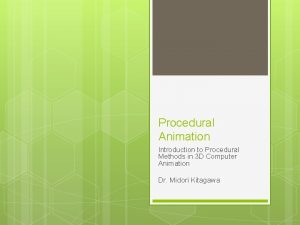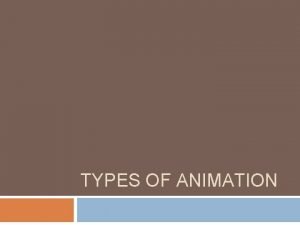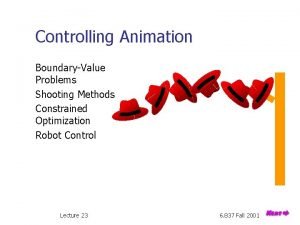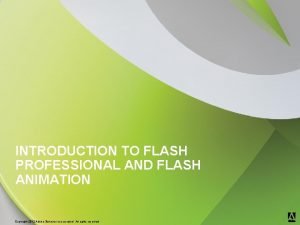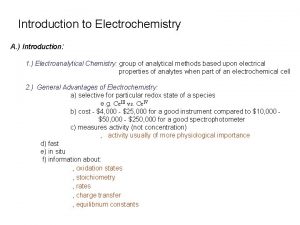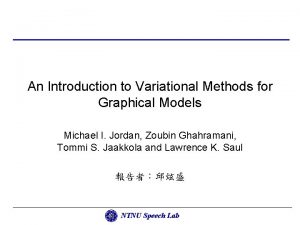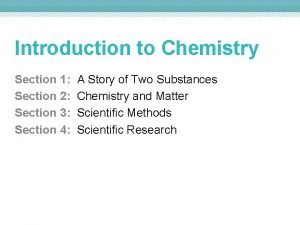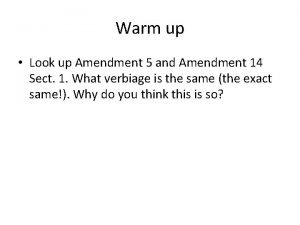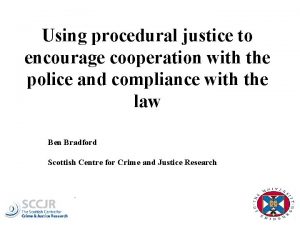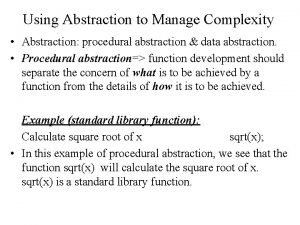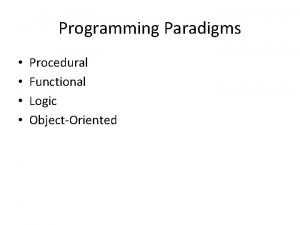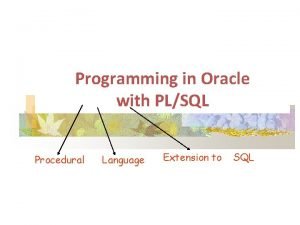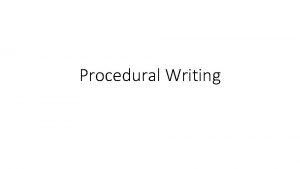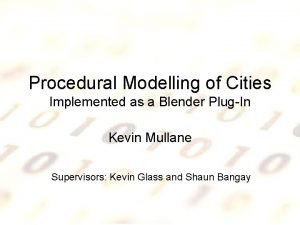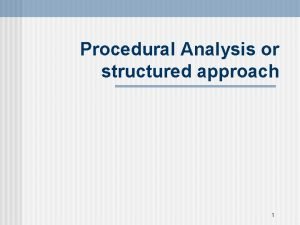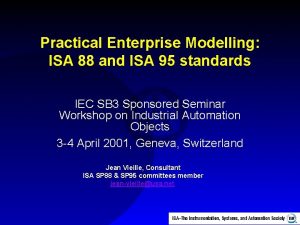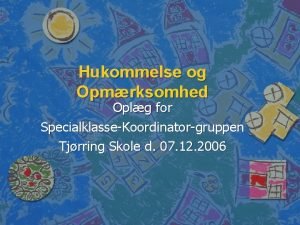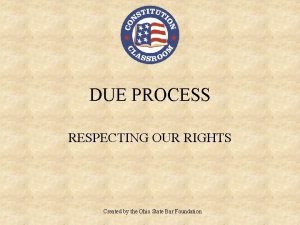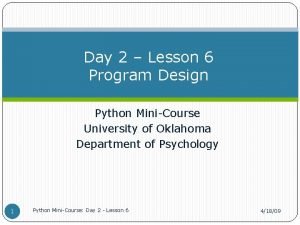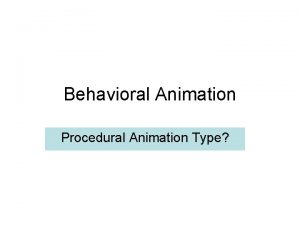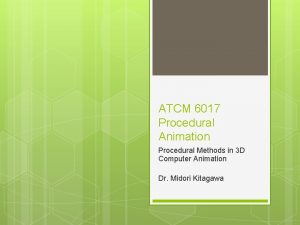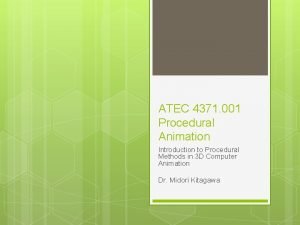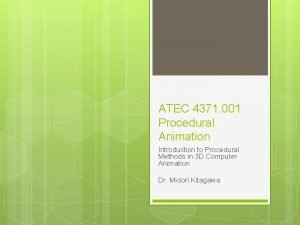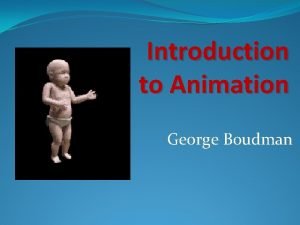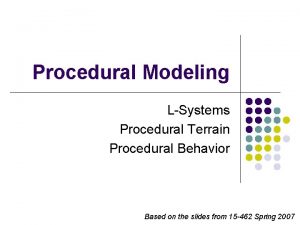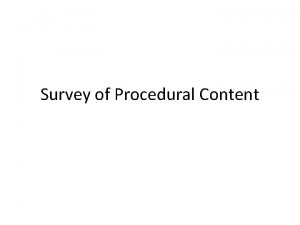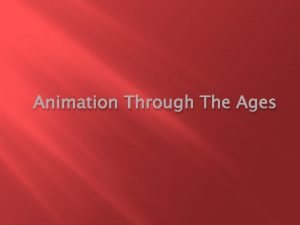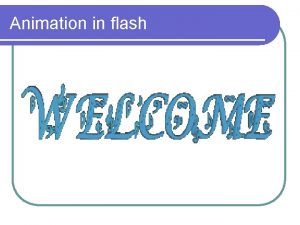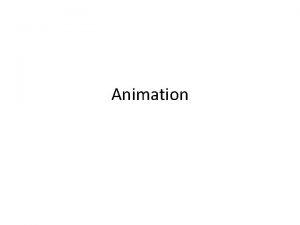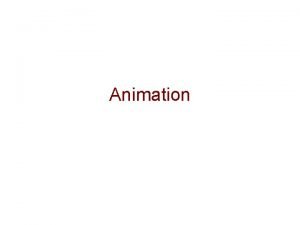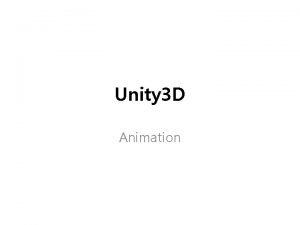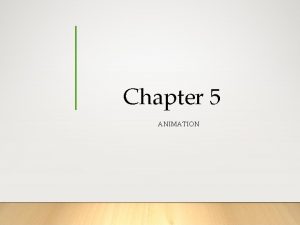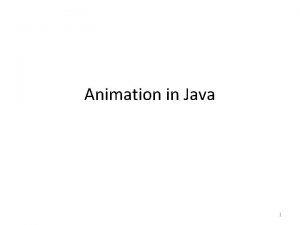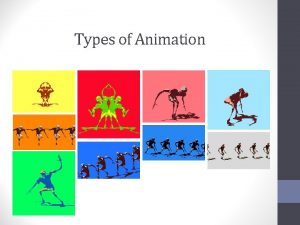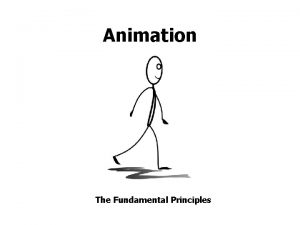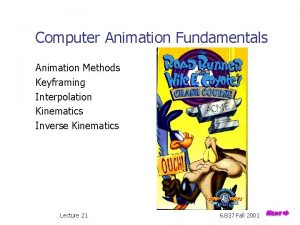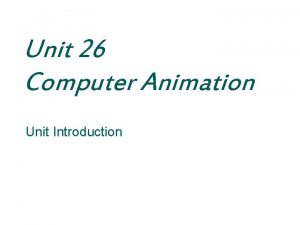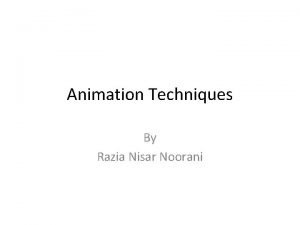Procedural Animation Introduction to Procedural Methods in 3
























- Slides: 24

Procedural Animation Introduction to Procedural Methods in 3 D Computer Animation Dr. Midori Kitagawa

In class Pay attention Take notes Learn Be ready for a pop quiz

Week 5: Modeling Types of 3 D models Polygons NURBS Metaball (demo) Most used SOPs (Vol 100 C 04) Groups SOP (demo)

Types of 3 D models and their use computer Surface Solid models Volume models animation, games 3 D printing, engineering, manufacturing, computer aided design (CAD) scientific visualization, medical visualization

Surface model Always has a crisp surface with no thickness. Can be closed or open. Composed of polygons or surface patches.

Solid model Used in 3 D printing, engineering, manufacturing, computer aided design (CAD), etc.

Solid model A solid model always has a crisp surface that divides the entire universe into two regions: the inside of the model and the outside of the model. A solid model is closed while a surface model can be open or closed. The interior of a solid model is homogeneous.

Volume model Used in scientific visualization, medical visualization

Volume model Consists of: Ø a data set of a physical characteristic (e. g, density, electric charge and temperature) measured at various locations in the space of interest, or Ø a field defined by mathematical equations.

Volume model The interior of a volume model is heterogeneous. Can have fuzzy surface.

Volume model Without converting into a surface or solid model, a volume model needs to be rendered by a special renderer. When surfaces are extracted from volume models, the volume models are called metaballs, implicit surfaces, blobby models or soft objects.

Metaballs Polygonization of an Isosurface is the set of all points in space where a given function is equal to a chosen constant threshold.

Metaballs Polygonization of an isosurface Polygonization of the surface is a set of polygons that approximate the form of the surface to the best of their resolution.

Metaballs Houdini metaball sample: http: //www. utdallas. edu/atec/midori/3316/Assignments/metaball_sample. hipnc

Types of 3 D models A surface model can represent an egg’s broken shell or complete shell. A solid model can represent an egg’s complete shell and the space enclosed by the sell. A volume model can represent an egg’s various parts -- shell, york, white, etc.

Polygons Plane figure bounded by three or more straight edges. Used most frequently in 3 D computer animation because they can be rendered faster than surface patches.

Polygons Good polygons are: single closed convex simple and planar.

Polygons Closed single simple planar polygons are almost always rendered correctly but open, non-single, non-simple, or skew polygons often causes rendering problems. If concave polygons are rendered incorrectly, triangulate a concave polygon into convex polygons. Triangulation eliminates skew (non-planar) polygons.

Polygons vs patches Polygon has straight edges and a flat surface. Surface patch has edges defined by curves (e. g. Bezier and NURBS) and curved surface.

NURBS curve Non-Uniform Rational B-Spline (NURBS) curve. Control vertices define the shape of a NURBS curve.

NURBS curve Offers a high degree of local curve control by using weights. The higher the weight of a control vertex, the more the curve segment is pulled towards that control vertex.

NURBS curve Sharp turn can be created at a control vertex by duplicating the control vertex or increasing the weight of the control vertex.

NURBS patch Defined by NURBS curves arranged in two directions U and V. Inherits all the characteristics of NURBS curves.

Most used SOPs Box, Circle, File, Font, Grid, Sphere, Platonic Solid Add, Attribute Create, Curve, Blast, Group, Color, Convert, Copy, Divide, Extrude, Facet, Line, Material, Merge, Meatball, Null, Object Merge, Point, Poly. Bevel, Primitive, Revolve, Skin, Sort, Subnet, Switch, Texture, Trail, Tube, Vertex, Transform
 2d procedural animation
2d procedural animation Traditional animation vs computer animation
Traditional animation vs computer animation Methods of controlling animation
Methods of controlling animation Direct and indirect wax pattern
Direct and indirect wax pattern Introduction to flash animation
Introduction to flash animation Introduction to electroanalytical methods
Introduction to electroanalytical methods An introduction to variational methods for graphical models
An introduction to variational methods for graphical models Introduction, method, result, and discussion
Introduction, method, result, and discussion Introduction to chemistry section 3 scientific methods
Introduction to chemistry section 3 scientific methods Equal protection clause
Equal protection clause What is procedural justice
What is procedural justice Example of procedural abstraction
Example of procedural abstraction Primary reliance on researcher to deal with procedural bias
Primary reliance on researcher to deal with procedural bias Procedural vs imperative
Procedural vs imperative Oracle procedural language extensions to sql
Oracle procedural language extensions to sql Procedure writing topics
Procedure writing topics Features of a procedural text
Features of a procedural text Blender procedural modeling
Blender procedural modeling Procedural analysis
Procedural analysis Types of knowledge in ai
Types of knowledge in ai Isa 88
Isa 88 Procedural hukommelse
Procedural hukommelse Substantive vs procedural due process
Substantive vs procedural due process Dpgt full form
Dpgt full form Python procedural
Python procedural
